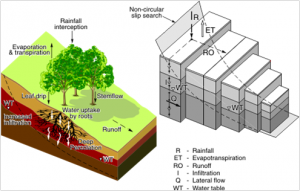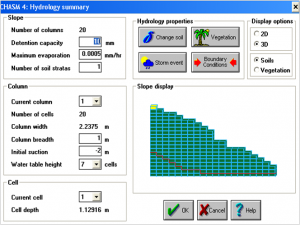Science Base
A landslide risk assessment with an appropriate scientific basis provides the foundation for designing a surafce water mnanagement intervention, and allows those advocating the measures to justify their recommendations. An understanding of the mechanisms that trigger landslides, and the scale at which they operate, is thus essential. The drivers of landslide risk can be summarized as:
 Physical drivers. Landslide hazard results from a combination of preparatoryfactors relating to slope geometry, soil and geology, vegetation, vegetation, surface water and groundwater regimes, and triggering mechanisms such as rainfall and seismic events. Tropical regions are especially susceptible to landslides because of high-intensity and -duration rainfall in the context of the deep soils (often on steep slopes) in such environments.
Physical drivers. Landslide hazard results from a combination of preparatoryfactors relating to slope geometry, soil and geology, vegetation, vegetation, surface water and groundwater regimes, and triggering mechanisms such as rainfall and seismic events. Tropical regions are especially susceptible to landslides because of high-intensity and -duration rainfall in the context of the deep soils (often on steep slopes) in such environments.
- Anthropogenic contributors. Even without climate change, anthropogenic activities are increasing landslide risk in some of the most vulnerable urban communities in developing countries. These activities include altering slope geometry with earthworks (cut and fill at the scale of household plots), loading slopes with buildings and infrastructure, changing the vegetation, and consequential changes in slope surface water and groundwater regimes. The pressure of development and population growth on available land means that the poorer, most vulnerable sections of society are often living on the most-marginal, landslide-prone hillsides
 Local scale: Since identification of landslide mitigation measures can only come from knowledge of local slope processes pertaining to the potential landslide trigger, MoSSaiC is designed to look within communities to examine and model the specific human and physical processes driving the landslide hazard.
Local scale: Since identification of landslide mitigation measures can only come from knowledge of local slope processes pertaining to the potential landslide trigger, MoSSaiC is designed to look within communities to examine and model the specific human and physical processes driving the landslide hazard.
The first stage in developing the scientific foundation for landslide risk reduction in communities is to acknowledge the highly localized scale of the physical and human hazard drivers.
